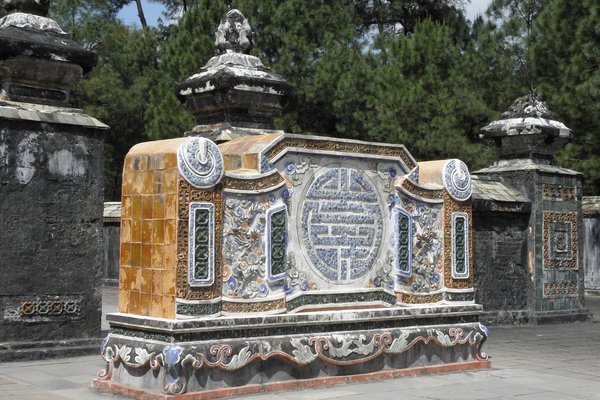Viet Nam
Hué
The Complex of Hué Monuments is a unique example of a planned and fully defended feudal capital city in Southeast Asia.
Hué was the imperial capital of Vietnam between 1802 and 1945. The site consists of the Capital City, a complex enclosed within defensive walls with the Forbidden Purple City at its heart, and associated monuments outside of the city such as imperial tombs, temples, pagodas and other spiritual sites.
Community Perspective: The Hué Citadel stands out for its unique design. The associated sites are also worth visiting, but are scattered across a large area so you’ll need a car/taxi/bike to reach them.
Site Info
Official Information
- Full Name
- Complex of Hué Monuments (ID: 678)
- Country
- Viet Nam
- Status
-
Inscribed 1993
Site history
History of Hué
- 1993: Inscribed
- Inscribed
- Type
- Cultural
- Criteria
- iii
- iv
Links
- UNESCO
- whc.unesco.org
- Official
-
- thuathienhue.gov.vn — Hue Portal
All Links
UNESCO.org
- whc.unesco.org — whc.unesco.org/
Official Website
- thuathienhue.gov.vn — Hue Portal
News Article
- May 27, 2025 e.vnexpress.net — Man detained for vandalizing throne of Vietnam's last royal family
- Oct. 27, 2014 tuoitrenews.vn — Entrance fees to Hue's monuments to be raised by April, 2015
- Nov. 16, 2013 archaeology.org — Break-In at the Tomb of Emperor Tu Duc in Hué
- Oct. 2, 2012 vietnamnews.vnagency.com.vn — Restoration of the temple of Princess Dien Phuoc funded by Japanese
- Sept. 29, 2009 google.com — Flooding hits Hué
- May 9, 2009 english.vietnamnet.vn — The 11km wall of the Hue royal citadel, a world cultural heritage site, has been seriously damaged by the encroachment of thousands of families
- Dec. 25, 2007 thanhniennews.com — The restoration of Linh Mu pagoda in Hue has been completed after more than four years of work.
- March 11, 2007 nhandan.com.vn — Long Duc, a palace located among the monuments in Vietnam's royal city of Hue - a World Heritage Site - began a restoration project on Tuesday worth VND 1.6 billion (US $100,000).
Community Information
- Community Category
- Urban landscape: Asian
- Secular structure: Military and Fortifications
Travel Information
Recent Connections
-
Perfect Inscriptions
1993 -
Locations for playing sport
Tiger Arena at 678-004 Royal Arena and … -
On beer cans and bottles
Hue Beer*See untappd.com
Connections of Hué
- Geography
-
-
South China Sea
-
Antipodes points
HISTORIC CENTRE OF CITY OF AREQUIPA=COMPLEX OF HUE MONUMENTS S16 24 0 W71 32 0 = N16 28 10 E107 34 40
-
- Trivia
-
-
Modelled after
Emperor Gia Long of Vietnam built a palace and fortress that was intended to be a smaller copy of the Chinese Forbidden City in the 1800s. -
On Banknotes
50000 dong ; Date of issue: 17 December 2003 -
On beer cans and bottles
Hue Beer*See untappd.com
-
- History
-
-
Eunuchs
Imperial Palace -
Located in a Former Capital
Vietnam (1775-1945) -
Sieges and Battles
Major losses occurred in 1947 when the Việt Minh seized the Citadel in February. The French led counter-attack laid siege and the six-week ensuing battle destroyed many of the major structures. The core of the city including the Imperial Palace was burned. The Citadel came under fire again on January 31, 1968, as part of the Tet Offensive a Division-sized force of People's Army of Vietnam and Viet Cong soldiers launched a coordinated attack on Huế seizing most of the city. Viet Cong troops occupied some portions of the citadel while South Vietnamese troops occupied others; and allied warplanes targeted the anti-aircraft guns the communists has mounted on the citadel's outer towers.See en.wikipedia.org
-
Forbidden City
"Inside the citadel was a forbidden city where only the concubines, emperors, and those close enough to them were granted access, the punishment for trespassing being death." (wiki) -
Coronation Locations
Coronation place for Nguyen Dynasty of Vietnam -
Feudalism
Hue represents an outstanding demonstration of the power of the vanished Vietnamese feudal empire (AB ev)
-
- Architecture
-
-
Chinese Garden
Many imperial mausoleum gardens and the recently restored Imperial citadel's garden are based on Chinese garden principal -
Octagons
Tien Mu Pagoda -
Geomancy
"The structures of The Complex of Huế Monuments are carefully placed within the natural setting of the site and aligned with the concept of oriential geomancy and Five elements[3] which including Five Cardinal Points (center, west, east, north, south), the Five Elements (earth, metal, wood, water, fire), and the Five Colors (yellow, white, blue, black, red)" (Wiki)
-
- Damaged
-
-
Damaged in War since WWII
Indo-China and Vietnam wars "The complex suffered considerably as a result of military operations in .... 1947 and 1968" (AB eval)
-
- World Heritage Process
-
-
First inscriptions
Vietnam 1993 -
Perfect Inscriptions
1993
-
- Religion and Belief
-
-
Pagoda
Thien Mu Pagoda (brick) - seven stories (21 meters); Nguyen Dynasty
-
- Human Activity
-
-
Locations for playing sport
Tiger Arena at 678-004 Royal Arena and Voi Re Temple -
Gilded Lacquer or Urushi
Forbidden Palace's halls are decorated with gold and red lacquer
-
- Constructions
-
-
Tombs
Khai Dinh tomb -
Cenotaph
The "empty" Tomb of Tu Duc: Despite the grandeur of the site and the amount of time Tu Duc spent here, he was buried in a different, secret location somewhere in Hue. To keep the secret safe the 200 laborers who buried the king were all beheaded after they returned from the secret route. To this day, the real tomb of Tu Duc remains hidden. (wiki) -
Walled cities
-
Bixi
At the Thien Mu pagodaSee en.wikipedia.org
-
Dynastic Burial Places
Tombs of the Nguyen Dynasty (1802-1945)
-
- WHS on Other Lists
-
-
World Monuments Watch (past)
Minh Mang Tomb, Hué City (2000, 1996)
-
- Timeline
-
-
Built in the 19th Century
Blossomed as capital of unified Viet Nam from 1802 on
-
- WHS Hotspots
News
- e.vnexpress.net 05/27/2025
- Man detained for vandalizing thron…
- tuoitrenews.vn 10/27/2014
- Entrance fees to Hue's monuments t…
- archaeology.org 11/16/2013
- Break-In at the Tomb of Emperor Tu…
Recent Visitors
Visitors of Hué
- AC
- Adam Hancock
- AK
- Albert
- Alberto Rodriguez Gutierrez
- Alejandro Lau
- Alexander Lehmann
- Alexander Parsons
- Alex Baranda
- Alex Goh
- Alex Marcean
- AlexSchedel
- Ali Zingstra
- Allegrazwindow
- ALS
- Ammon Watkins
- AmyAbroad
- AndreaTLV
- arina_soboleva
- arnaugir
- Artur Anuszewski
- Aspasia
- Atila Ege
- Badwater
- Balu93
- Bamse
- basementonline
- beckyjo27
- BenReeve
- Bernard Joseph Esposo Guerrero
- Bill Maurmann
- Bodil Ankerly
- Boj
- Bram de Bruin
- c82wc1
- CampbellME
- Can SARICA
- Carlo Sarion
- CeeMon
- Chalamphol Therakul
- chenboada
- chenqtao
- chiuliqi
- Christravelblog
- Cirene Moraes
- Claire Bradshaw
- Colossus
- Corinne Vail
- CugelVance
- cutecid
- cwthong
- Cyberczar
- CynthiaSam
- Daniela Hohmann
- Danny L
- David Marton
- David Scott King
- Delphine Delaunay
- Dimitar Krastev
- DouglasR
- Dylan
- Elaine McArdle
- Elisabeth Fransisca Situmorang
- eljx1988
- Els Slots
- Erfe91
- Erik Jelinek
- Errol Neo
- Fan Yibo
- fedemarch92
- Federico P.
- Feldhase
- Felicité
- Fernweh
- finsbury_jo
- Francky D'Hoop
- Frederik Dawson
- FS
- Garrett
- Gary Arndt
- George Gdanski
- GerhardM
- Gernot
- Gilles
- giloudepuertorico
- Hammeel
- Harald T.
- Harry Mitsidis
- Hdhuntphotography
- headventure
- henrik_hannfors
- Highlander
- hotpickle
- Iain Jackson
- Ingrid
- inomusay
- irosey
- Ivan Rucek
- ivantham
- Jackson
- Jacob Otten
- Jakubmarin
- Jana and Matt
- Janos
- Jarek Pokrzywnicki
- Javier Coro
- jballard650
- Jeanne OGrady
- Jens
- JL
- Joel on the Road
- Jonas Martinsson
- jonathanfr
- Joyce van Soest
- Justin Rickey
- jxrocky
- KarenBMoore
- KeithBailey
- kelseyyurek
- Ken DJ
- Kerékgyártó
- Kim, Soo-youn
- Kjlauer
- Krijn
- Kurt Lauer
- Lara Adler
- Lars Bogstad
- Laurine
- Lazerway
- lichia
- Lillybett
- Loic Pedras
- Luboang
- Lucio
- Ludvan
- Luis Filipe Gaspar
- Lukasz Palczewski
- Luke LOU
- lynnz317@aol.com
- Maciej Gil
- Maciej Gowin
- Malgorzata Kopczynska
- Manon R
- Marinemajor
- Martin
- Martina Rúčková
- maryhattie
- Matthewsharris
- MaYumin
- Mia esguerra
- Michael Turtle
- Mikko
- Miloš Tašković
- MMM
- Morodhi
- Naim Y
- nan
- Nicole Lampos
- Nihal Ege
- Olli-Pekka Turunen
- _oscar
- PabloNorte
- Patrik
- Patrik_globe
- Paul Schofield
- Pchxiao
- petar
- Peter Lööv
- pete_simms
- Philipp Leu
- phillipmeng
- Pieter Dijkshoorn
- Pink Bunny
- Potsdamer
- Qin Xie
- Ralf Rotheimer
- Randi Thomsen
- ReallyDeepThoughts
- reddargon
- Reiseblitz
- Reza
- Riccardo Quaranta
- Roel Sterken
- S. Anril Tiatco
- saraleonela
- Sclowitz
- scubarrie
- Sergio Arjona
- Shandos Cleaver
- Shannon O'Donnell
- sibariam
- sime147
- Simonf
- sncjob
- Solivagant
- Stanislaw Warwas
- Stefan Loov
- stephanvermeulen
- stephhollett
- SteveD92
- Sutul
- Svein Elias
- SymonMajewski
- Szabolcs Mosonyi
- Szucs Tamas
- Tamara Ratz
- Tammy Gouldstone
- Taotao Chen
- Tevity
- Thanneermalai L
- Thomas Buechler
- Thomas van der Walt
- Tim Allen
- Timonator
- Timothy C Easton
- TimPick
- tony0001
- Tony H.
- Tree99
- trekkie900
- Truls Brekke
- usagi1974
- valentinaui
- Van Hung
- Vernon Prieto
- Vincent Cheung
- VMThumper
- voyager
- WestcountryWanderer
- Westwards
- Wojciech Fedoruk
- Wo_ko
- Xiquinho Silva
- Yongcheng Liu
- Zach
- zfish
- Zoë Sheng
- Zos M
- ZZSong
Community Reviews
Show full reviews
Time of the visit:22nd -26th,april,2025.
On the 22nd I arrived in Hue around 15.00.I just took a long walk around a large part of the inner outer areas of the citadel without entering the citadel as it was quite late.The following day I entered the huge citadel around 11.00 am and stayed there till around 17.30.It was an extremely hot day so that I needed far more time to visit all sections within the big citadel. The heat made me take far more breaks than intended.On a cooler day 3 h would have been sufficient to visit the entire citadel.
On the 24th I rented a bicycle in order to visit some of the tombs outside Hue.That day it was even hotter than the day before.My first destination was the temple of letters where I stayed less than 10 min as there wasnt much to see.I then rode to the Thien-Mu-Pagoda which was quite disappointing and underwhelming but easy to reach by bike.I then crossed the river and visited the Royal Arena and the nearby Voi Re lake.The arena was closed and not really worth a visit.I continued my trip to the tomb of the emperor Tu Duc.To my great dismay there are no combo tickets with several other tombs...only a citadel ticket with three tombs.I had to buy that ticket as a single ticket for every tomb costs 150.000 dongs.Quite pricey.The Tu Duc tomb turned out to be a very interesting one.It is also the most popular …
Keep reading 0 comments
Most tourists use Hué as their base to visit the DMZ and other war memorials. Our hotel had a "menu" of tours provided to us at the check-in by the reception. But we skipped those and went for half-day sightseeing before taking a transfer to Hoi An.
First stop was the Imperial City, which was very impressive. Ivan noted the overall structure was similiar to the Forbidden City in Beijing he visited recently, though obviously a tad bit smaller. There's a ticket booth on the left of the main walls, after you pass the bridge through the Perfume River. I remember it was quite pricey, 200- or 300 000 dongs per person if I remember correctly. However it is worth it as the whole area is huge with many different colourful buildings: palaces, theatre, library, temples and pavilions - one even in the shape of swastika. Everything has obviously been restored: the colours are vibrant, the place is well signposted, the lawns are taken care of. As recommended by previous reviewers, it's almost completely empty after the Royal Palace itself, the more to the side or to the back you get, the less people there are. As we went the early morning, there was almost nobody in the back. Oh, and I really enjoyed the colourful exit gate.
After that we took a taxi to the Thien Mu Pagoda. That was quite crowded, despite the rain. There are some nice views over the river and the park around …
Keep reading 0 comments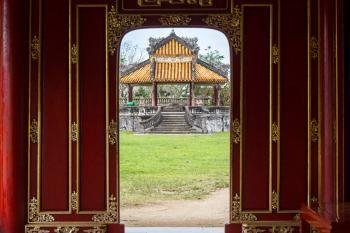
The Imperial City is the main attraction of Hue and one of the few sights that you would see when you come to the city. Luckily, it's an impressive World Heritage Site that certainly justifies a visit.
The Imperial City is a large complex that takes me more than two hours to explore, wandering through the different sections. Much of it was destroyed during the 'American War' and many of the buildings you'll see have been restored or completely rebuilt. It also means there are large empty sections where no work has been done yet.
But what is here paints a vivid picture of the last dynasty of Vietnam (the one that shaped it in the form we find today). The main entrance gate is the most striking of the buildings, but I enjoy the detail of the Thai Hoa Palace, and the elegant red and gold patterns on the wall of the Can Thanh Palace. In hindsight, I do wish I had hired a guide or brought some reading material, because the explanations of what you're seeing aren't particularly detailed unfortunately.
This part of Vietnam is quite rich with cultural World Heritage Sites. As well as visiting the Hue Imperial City, you could use the city as a base to visit the My Son Sanctuary and to see Hoi An (although it makes for a good place to stay in itself). Within Hue itself, I would also recommend seeing some of the pagodas and tombs …
Keep reading 0 comments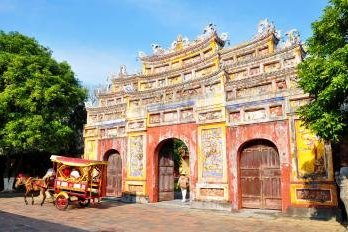
On my way to Danang Airport, I looked back on the past few days I spent in the former capital of Imperial Viet Nam, Hue, which in my opinion, one of the great cultural cities that actually should be on the same league with Beijing, Seoul or Kyoto, but after many wars and conflicts, only fragment of its glories remains. When I first saw the wall of Hue Citadel, I was really impressed as the wall is really different from other city wall I saw in other parts of Asia, a combination of Asian and French Vauban fortification design, something really unique. The Flag Tower is really impeccable in design and the square and pavilions next to the river are really picturesque. When I crossed the bridge to see inside the citadel, I again impressed for the design of the Gate Tower, simple but really elegant and when I saw the square in front of the main gate to the imposing Imperial Palace behind the flag tower, I said WOW immediately, for its perfect size and overall landscape design.
The palace is a bit simple but still preserved the original idea of oriental palace perfectly with many unique designs that I could not find anywhere else. Then I proceeded to other parts of the palace, and I found many empty spaces or ruins of destroyed buildings, only few structures still remained. The best-preserved area maybe the Ancestral Shrine, simple with Confucius element, a richer decorated version …
Keep reading 0 comments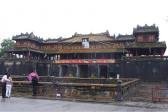
I visited the citadel of Hue and the associated tombs in february 2012. In spite of the rain, I found the place amazing, especially the Khai Dinh tomb which offered greatly decorated rooms. The best way to go to the different tombs if you have not a lot of time, is to book a tour in the city, to visit the citadel, the pagoda and the three main tombs in one day.
Keep reading 0 comments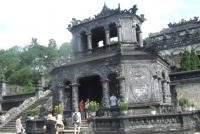
As Els says, the tombs of Hue are widely scattered, some more than 10 kms from the city centre. But they are reachable by taxi, or by boat along the Perfume River. One that I visited was the colourful tomb of Ming Mang, where you pass through several gates and temples before reaching the actual tomb on a hillside at the rear of the complex. Another was the tomb of Khai Dinh, a complex of grey stone with lots of steps and elaborate stone decorations.
While touring the district I also visited the tombs of Tu Duc and Duc Duc as well as the Thien Mu Pagoda.
Inside Hue itself the huge Citadel, a complex of many differing styles filled a large area. The memorial house in Phan Dinh Phung Street and the An Dinh Palace were much smaller, but were all within walking distance of the city centre.
Keep reading 0 comments
Glazed tiles all over the place! That was the first thing that struck me when entering the Citadel. Not only the common Chinese yellow roof tiles but also a kind of porcelain mosaics that I had never encountered before - fragments of blue & white vases that have been put together to form new designs on the outer walls of buildings and gates.
The Citadel is a pleasantly quiet place to walk around for a couple of hours. It's a very busy site near the entrance gate, but I was almost on my own at the back of the complex and at the fringes. My favourite building here was the Truong San Residence, with its great yellow entrance gate. This and most of the other objects look very recently painted and/or restored. Over-restored maybe, I wonder what our Forum would have to say about this one.
A visit to the Hué monuments is not complete without seeing some of the places outside the city. For that, I rented a bicycle and set off south. The first kilometers out of Hué are easygoing. Every 10 minutes or so there's an interesting stop - I visited Nam Giao esplanade, heard the monks chanting at the very peaceful Tu Hieu pagoda, and joined the busloads of tour groups again at the Tomb of Tu Duc. There is a "Tomb" here (though empty), but it actually was more of a country house & pleasure park for the emperor. It still is a …
Keep reading 0 comments
